Post #1 · Posted at 2010-01-12 09:21:53pm 15.9 years ago
 Chi Chi | |
|---|---|
| Member | |
| 290 Posts | |
 | |
| Reg. 2009-02-05 | |
DISCLAIMER: Follow these instructions at your own risk, and be careful. I'm not responsible for your handiwork or lack of soldering skills! And if I've made a mistake (I don't think I have, but those are famous last words), then I'm very sorry but have you heard? The story of the Golden Ninja Warrior?
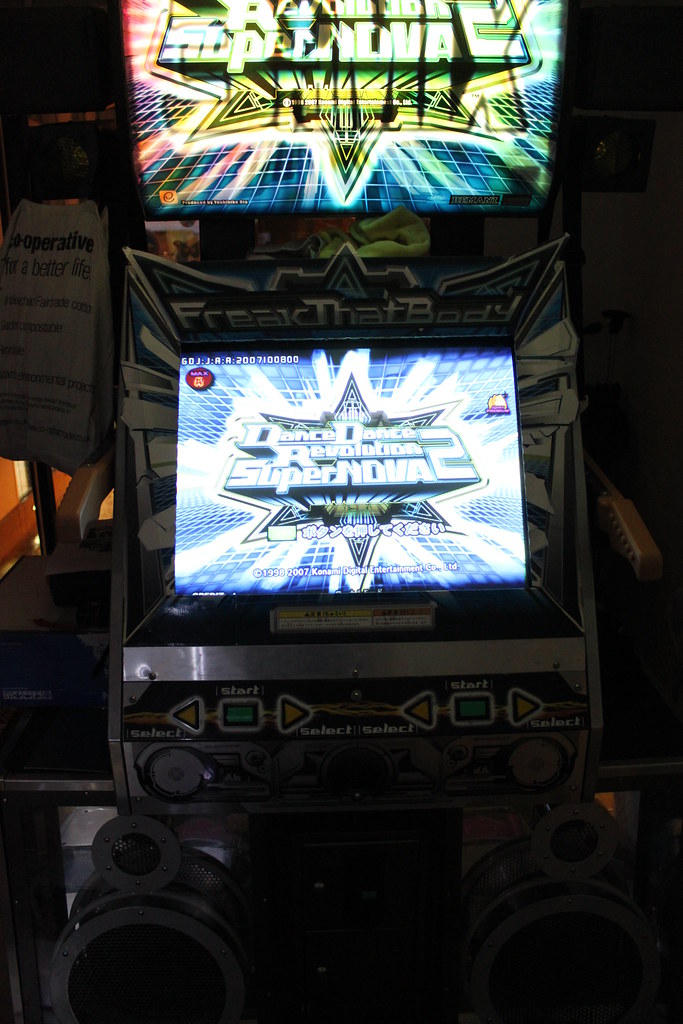
This thread is a guide to setting up Python 2-based DDR games (SuperNOVA, SuperNOVA 2) on a classic DDR doubles cabinet. Note: you can't get it working on anything except for a legit DDR doubles cab. Comments, corrections and questions are encouraged. If you want to redistribute it elsewhere for whatever reason, do iiiiit.
Before anyone asks, I am not aware of any pirated or bootlegged arcade versions of SuperNOVA or SuperNOVA 2 - I imported my motherboard (and marquee and control panel) from Yahoo Auctions Japan just under a year ago (when all the JP arcades upgraded to DDR X). It's legit (albeit Japanese, not European so I wouldn't be able to put it out on location. It never officially came out in Europe anyway due to the lovely RoHS regulations).
Big shout out and thanks to my main man Zash (for acting as middleman in my quest to get an Ext I/O, and for various conversations over email and PM, for testing that the MC_PWR connection isn't needed, and for actually putting all this into practice by getting his SN2 up-and-running first [and posting pics] ). Also thanks to zorahk for clarifying info about the white security plug.
). Also thanks to zorahk for clarifying info about the white security plug.
Some of the images are clickable and will take you to my flickr account, where you can get biiiiiig resolution versions. Some are not. The full set is here:
http://www.flickr.com/photos/chi-ryu/tags/supernova2upgrade/
Basic Overview:
You need the following items:
1) Python 2 unit (A.K.A. PS2-in-a-box) with DDR installed and a BLACK security plug[1].
2) Extended I/O unit (EXTIO).
3) Cabling to convert the lights and other I/O plugs into the correct format (see section III), and to provide power to the Python 2 and Ext I/O units.
4) A 100VAC power source - most likely you already have this inside your cabinet[2] (every Japanese and Asian cab I've seen has a 110/120V internal power source off the transformer, but I make no guarantees that every cab in existence does). In particular, I have no idea about EU-distributed Dancing Stage/EuroMIX/EM2 cabinets.
I) Python 2 unit:
The Python 2 unit is the main part for SuperNOVA and SuperNOVA 2.
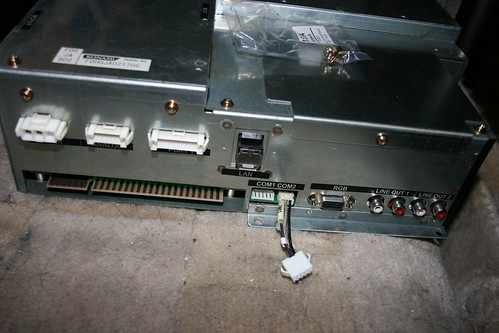
Lol, it's literally a PS2-in-a-box:
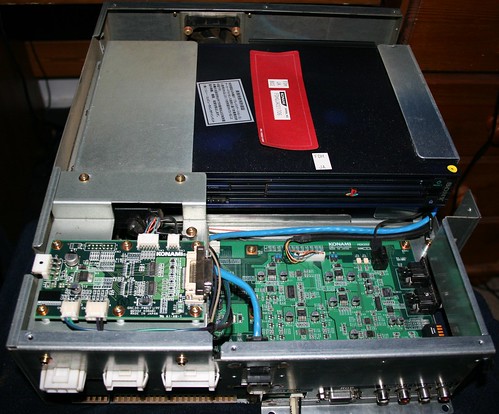
II) Extended I/O unit:
Konami Part number: GKE33-PWB

This converts the lights and pad I/O into the serial format needed for Python 2-based DDR. Without this, the game will throw an I/O error and refuse to boot into game mode (have fun with the service menu if you like, though). Hardware-wise, it looks to be quite simplistic (2 ICs and a bunch of other smaller components), so it's probably possible to reverse engineer it quite easily if someone has the time.
SOURCING THE EXT I/O UNIT
Sadly, the only way to get this at the moment is through Konami's distributors (Betson in the US, Electrocoin in EU), and it's not cheap. The list price in the US is $585, and in the UK/EU it is £659+VAT.
Betson have proved to be a bit flaky with regards to communications - they've outright refused to sell to someone in the US in the past on the grounds that he didn't have a valid US serial number (since he was using a Japanese SuperNOVA 2 main board), and it took me 8 months (and several unanswered emails) to finally get in touch with someone at Betson who actually was competent at his job and replied to emails!
III) Cabling:
There's a bunch of cables required to get this all up and running. The official Konami part numbers are:
[*]GKFDHUA00012 - Neon -> Ext-I/O PCB
[*]GKFDHUA00010 - 1P Lamp -> Ext-I/O PCB
[*]GKFDHUA00011 - 2P Lamp -> Ext-I/O PCB
[*]GKFDHUA00014 - 12V power
[*]GKFDHUA00003 - SCI -> Ext-I/O PCB)
[*]GKFDHUA00013 - Ext-I/O in -> Ext-I/O PCB
[*]GKFDHUA00004 - Lamp PCB -> Python 2 motherboard
...Unless you like soldering cables yourself, you might also like to get a quote for a replacement SN JAMMA loom and these two power cables:
[*] GKFDHUA00007 - JAMMA Loom
[*] GKFDHUA00005 - MC_PWR and 12V power cables
...And if you want to be a completist:
[*] GKFDHUA00061 and GKFDHUA00062 - 120V-100V Transformer and cable
My local distributor wanted GBP£395+taxes for these, so I made my own.
MAKING YOUR OWN CABLES
If you are rolling your own, you'll need to make the following cables:
1) EXTIO power (12V) [Connector: VHR-3N to your DC power supply]
2) Python 2 power (100V) [Connector: VLP-03V, other end to your AC power supply]
3) 1P lights -> EXTIO [Connectors: XMR-10V to XHP-10]
4) 2P lights -> EXTIO [Connectors: XMR-10V to XHP-12]
5) Bass Neon -> EXTIO [Connectors: XMR-06V to XHP-6]
6) Python 2 -> EXTIO [Connectors: EHR-5 to XHP-3]
7) EXTIO -> Jamma loom [Connector: XHP-5, other end soldered onto the JAMMA loom]
8) Cab lights -> Python 2 [Connectors: XMR-10V to XMP-11V]
9) (OPTIONAL and not needed) Python 2 MC_PWR (5V) [Connector: VHR-4N, other end to your DC power supply]
You'll need the following JST edge connectors:
3 x XMR-10V : Socket for 1P,2P and cab lights from cabinet (I scavenged these from a broken System 573 to save effort)
1 x XMR-06V : Socket for Neon from cabinet (I scavenged these from a broken System 573 to save effort)
1 x VHR-3N : +12V Power for Ext I/O
1 x XHP-3 : Ext I/O to P2 COM1, Ext I/O end
1 x XHP-5 : From JAMMA to Ext I/O
1 x XHP-6 : Neon connector to Ext I/O
1 x XHP-10 : Ext I/O 1P Lights
1 x XHP-12 : Ext I/O 2P Lights
1 x EHR-5 : Ext I/O to P2 COM1, Python 2 end
1 x XMP-11V : To Python 2 (Lamp)
1 x VLP-03V : Python 2 100V power
1 x VHR-4N : MC_PWR +5V (NOT NEEDED, BUT ON THE SCHEMATICS)
You'll need a bunch of pins for these connectors, too:
3 x SEH-001T-P0.6 : EHR contacts
23 x SXA-001T-P0.6: XMR contacts
8 x SXM-001T-P0.6 : XMP contacts
24 x SXH-001T-P0.6 : XHP contacts
4 x SVH-21T-P1.1 : VHR contacts
2 x SVF-42T-P2.0 : VLP contacts
The XMR-connectors I scavenged off a broken System 573 board to save time and effort - they are simply the 4 lights sockets on a 573 motherboard, and can be entirely detatched from the Analogue or Digital I/O board, and then popped out from the face plate.
1) EXTIO power:
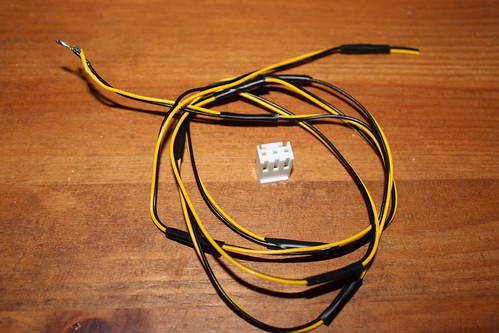
Trivial: Pin 1 goes to a +12V source (e.g. JAMMA pin 6 or from your cab's DC power supply), and pin 2 to ground (e.g. JAMMA pin 1)
2) Python 2 power:
Wire pin 1 and pin 2 into an AC 100V supply. The Python 2 unit does not use or require an earth wire. From a functional point of view, it doesn't matter which way round you do this (strictly speaking pin 1 should be AC neutral and pin 2 AC live/hot, but since it's a PS2 in a plastic case inside a sealed unit, it shouldn't be a safety issue if you get it the wrong way round, though as a general principal you should get this the right way round on mains AC stuff).
3) 1P lights -> EXTIO
4) 2P lights -> EXTIO
5) Bass Neon -> EXTIO
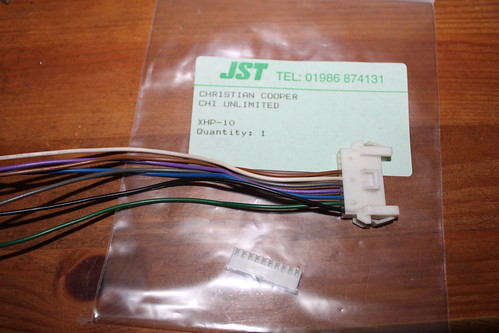
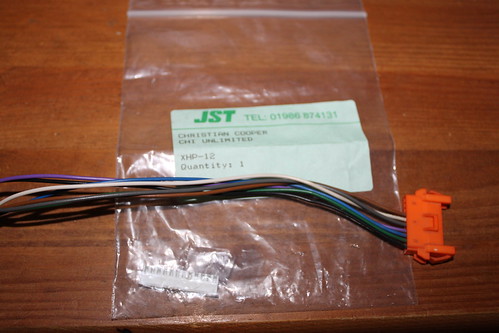
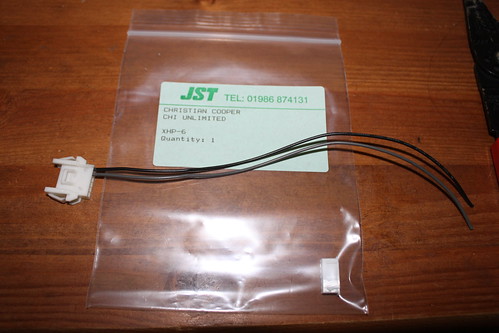
These are all straight pin-to-pin wirings. The 1P connector (white) goes to the 10-pin XHP housing, the 2P connector (orange) goes to the 12-pin one. The bass neon is the 6-pin white connector.
When finished they'll look like this (2P only shown):
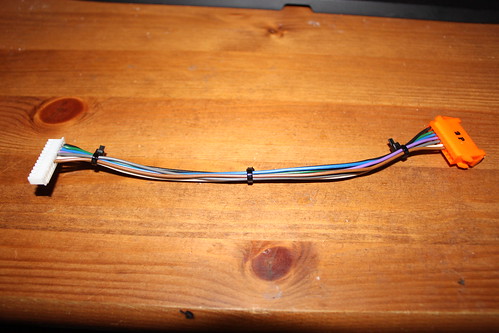
6) Python 2 -> EXTIO [Connectors: EHR-5 to XHP-3]

This is a serial data crossover cable. If you get this wrong, SuperNOVA will give an error when booting and drop out into the operator menu.
Wiring:
EHR pin 1 to XHP pin 2
EHR pin 2 to XHP pin 1
EHR pin 5 to XHP pin 3
7) EXTIO -> Jamma loom [Connector: XHP-5, other end soldered onto the JAMMA loom]
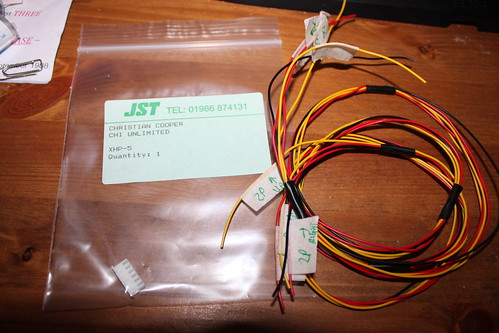
Wiring:
Pin 1 soldered onto JAMMA 1P UP (pin 18)
Pin 2 soldered onto JAMMA 1P RIGHT (pin 21)
Pin 3 soldered onto JAMMA 2P UP (pin V)
Pin 4 soldered onto JAMMA 2P RIGHT (pin Y)
Pin 5 soldered onto JAMMA ground (e.g. pin 1)
8) Cab lights -> Python 2 [Connectors: XMR-10V to XMP-11V]
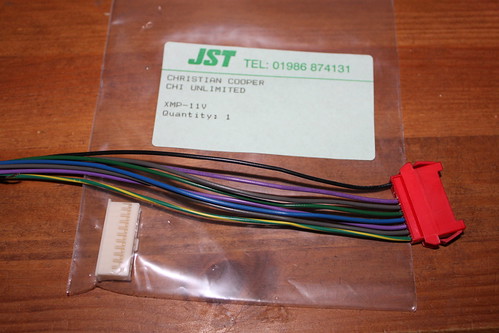
Wiring:
XMR Pin 1 to XMP pins 1 and 6 (grounds)
XMR Pin 4 to XMP pin 2
XMR Pin 5 to XMP pin 3
XMR Pin 6 to XMP pin 7
XMR Pin 7 to XMP pin 8
XMR Pin 8 to XMP pin 9
XMR Pin 9 to XMP pin 10
XMR Pin 10 (earth) not required.
When finished it'll look like this:
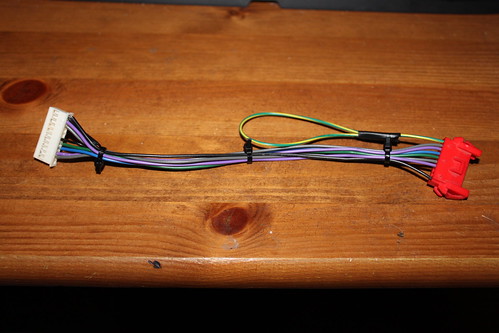
9) (OPTIONAL and not needed) Python 2 MC_PWR (5V)
As with cable #1, this is trivial. Pin 1 goes to +5V (e.g. JAMMA pin 3 or from your cab's DC power supply), pin 2 to ground (e.g. JAMMA pin 1). It's also not needed - this is used to power the memory card sub-board on the Python 2, which ultimately was not used in SuperNOVA/SN2.
When it's all finished and cabled up, it sohuld look a bit like this:
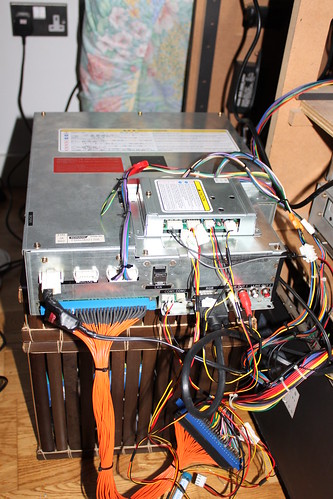
On a Korean cab, there's space to store the old System 573 unit on top of the Python 2 unit for quick changes (you might not be able to do this with a Japanese cab as they store the units vertically instead of horizontally):
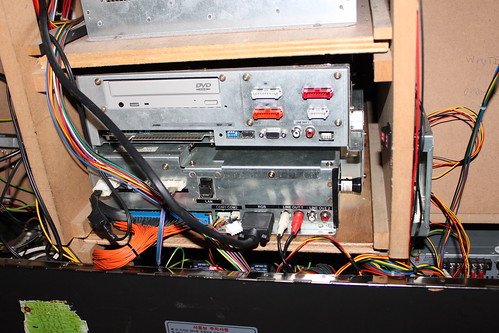
FINAL NOTE: By default, Python 2 outputs 15kHz (nominally this is at 0.7Vp-p through the D-sub connector, and 3.3Vp-p (arcade monitor voltage) on the JAMMA. To switch this to 31kHz (if you have a suitable monitor), simply bridge together JAMMA pins S and M (thanks to Zash for pointing this out!).
Appendix A) Schematics:
Annotated SuperNOVA schematics (showing the differences from ye olde cabs) can be found here:
http://www.flickr.com/photos/chi-ryu/tags/snvsoldddr/
Appendix B) JAMMA Pinouts
A breakdown of the JAMMA pinouts can be found e.g. here: http://www.coin.demon.co.uk/jamma.htm
[1] Often these units are seen with two security plugs (one black one white) - you only need the black one. The white one is a hardware identifier plug - used to identify the machine on e-Amusement, amongst other things.
[2] Usually there is an internal 120VAC source for cabinets used outside of Japan, but it doesn't really make a difference in practical terms. If you want to be a completest, get a 120V-100V stepdown for the Python 2 (you can find them in airports in Japan, or mail ordered for silly money), but I didn't bother. If you are happy enough to run a Japanese Playstation 2 from US mains/120V stepdown, this is literally no different.

This thread is a guide to setting up Python 2-based DDR games (SuperNOVA, SuperNOVA 2) on a classic DDR doubles cabinet. Note: you can't get it working on anything except for a legit DDR doubles cab. Comments, corrections and questions are encouraged. If you want to redistribute it elsewhere for whatever reason, do iiiiit.
Before anyone asks, I am not aware of any pirated or bootlegged arcade versions of SuperNOVA or SuperNOVA 2 - I imported my motherboard (and marquee and control panel) from Yahoo Auctions Japan just under a year ago (when all the JP arcades upgraded to DDR X). It's legit (albeit Japanese, not European so I wouldn't be able to put it out on location. It never officially came out in Europe anyway due to the lovely RoHS regulations).
Big shout out and thanks to my main man Zash (for acting as middleman in my quest to get an Ext I/O, and for various conversations over email and PM, for testing that the MC_PWR connection isn't needed, and for actually putting all this into practice by getting his SN2 up-and-running first [and posting pics]
Some of the images are clickable and will take you to my flickr account, where you can get biiiiiig resolution versions. Some are not. The full set is here:
http://www.flickr.com/photos/chi-ryu/tags/supernova2upgrade/
Basic Overview:
You need the following items:
1) Python 2 unit (A.K.A. PS2-in-a-box) with DDR installed and a BLACK security plug[1].
2) Extended I/O unit (EXTIO).
3) Cabling to convert the lights and other I/O plugs into the correct format (see section III), and to provide power to the Python 2 and Ext I/O units.
4) A 100VAC power source - most likely you already have this inside your cabinet[2] (every Japanese and Asian cab I've seen has a 110/120V internal power source off the transformer, but I make no guarantees that every cab in existence does). In particular, I have no idea about EU-distributed Dancing Stage/EuroMIX/EM2 cabinets.
I) Python 2 unit:
The Python 2 unit is the main part for SuperNOVA and SuperNOVA 2.

Lol, it's literally a PS2-in-a-box:

II) Extended I/O unit:
Konami Part number: GKE33-PWB

This converts the lights and pad I/O into the serial format needed for Python 2-based DDR. Without this, the game will throw an I/O error and refuse to boot into game mode (have fun with the service menu if you like, though). Hardware-wise, it looks to be quite simplistic (2 ICs and a bunch of other smaller components), so it's probably possible to reverse engineer it quite easily if someone has the time.
SOURCING THE EXT I/O UNIT
Sadly, the only way to get this at the moment is through Konami's distributors (Betson in the US, Electrocoin in EU), and it's not cheap. The list price in the US is $585, and in the UK/EU it is £659+VAT.
Betson have proved to be a bit flaky with regards to communications - they've outright refused to sell to someone in the US in the past on the grounds that he didn't have a valid US serial number (since he was using a Japanese SuperNOVA 2 main board), and it took me 8 months (and several unanswered emails) to finally get in touch with someone at Betson who actually was competent at his job and replied to emails!
III) Cabling:
There's a bunch of cables required to get this all up and running. The official Konami part numbers are:
[*]GKFDHUA00012 - Neon -> Ext-I/O PCB
[*]GKFDHUA00010 - 1P Lamp -> Ext-I/O PCB
[*]GKFDHUA00011 - 2P Lamp -> Ext-I/O PCB
[*]GKFDHUA00014 - 12V power
[*]GKFDHUA00003 - SCI -> Ext-I/O PCB)
[*]GKFDHUA00013 - Ext-I/O in -> Ext-I/O PCB
[*]GKFDHUA00004 - Lamp PCB -> Python 2 motherboard
...Unless you like soldering cables yourself, you might also like to get a quote for a replacement SN JAMMA loom and these two power cables:
[*] GKFDHUA00007 - JAMMA Loom
[*] GKFDHUA00005 - MC_PWR and 12V power cables
...And if you want to be a completist:
[*] GKFDHUA00061 and GKFDHUA00062 - 120V-100V Transformer and cable
My local distributor wanted GBP£395+taxes for these, so I made my own.
MAKING YOUR OWN CABLES
If you are rolling your own, you'll need to make the following cables:
1) EXTIO power (12V) [Connector: VHR-3N to your DC power supply]
2) Python 2 power (100V) [Connector: VLP-03V, other end to your AC power supply]
3) 1P lights -> EXTIO [Connectors: XMR-10V to XHP-10]
4) 2P lights -> EXTIO [Connectors: XMR-10V to XHP-12]
5) Bass Neon -> EXTIO [Connectors: XMR-06V to XHP-6]
6) Python 2 -> EXTIO [Connectors: EHR-5 to XHP-3]
7) EXTIO -> Jamma loom [Connector: XHP-5, other end soldered onto the JAMMA loom]
8) Cab lights -> Python 2 [Connectors: XMR-10V to XMP-11V]
9) (OPTIONAL and not needed) Python 2 MC_PWR (5V) [Connector: VHR-4N, other end to your DC power supply]
You'll need the following JST edge connectors:
3 x XMR-10V : Socket for 1P,2P and cab lights from cabinet (I scavenged these from a broken System 573 to save effort)
1 x XMR-06V : Socket for Neon from cabinet (I scavenged these from a broken System 573 to save effort)
1 x VHR-3N : +12V Power for Ext I/O
1 x XHP-3 : Ext I/O to P2 COM1, Ext I/O end
1 x XHP-5 : From JAMMA to Ext I/O
1 x XHP-6 : Neon connector to Ext I/O
1 x XHP-10 : Ext I/O 1P Lights
1 x XHP-12 : Ext I/O 2P Lights
1 x EHR-5 : Ext I/O to P2 COM1, Python 2 end
1 x XMP-11V : To Python 2 (Lamp)
1 x VLP-03V : Python 2 100V power
1 x VHR-4N : MC_PWR +5V (NOT NEEDED, BUT ON THE SCHEMATICS)
You'll need a bunch of pins for these connectors, too:
3 x SEH-001T-P0.6 : EHR contacts
23 x SXA-001T-P0.6: XMR contacts
8 x SXM-001T-P0.6 : XMP contacts
24 x SXH-001T-P0.6 : XHP contacts
4 x SVH-21T-P1.1 : VHR contacts
2 x SVF-42T-P2.0 : VLP contacts
The XMR-connectors I scavenged off a broken System 573 board to save time and effort - they are simply the 4 lights sockets on a 573 motherboard, and can be entirely detatched from the Analogue or Digital I/O board, and then popped out from the face plate.
1) EXTIO power:

Trivial: Pin 1 goes to a +12V source (e.g. JAMMA pin 6 or from your cab's DC power supply), and pin 2 to ground (e.g. JAMMA pin 1)
2) Python 2 power:
Wire pin 1 and pin 2 into an AC 100V supply. The Python 2 unit does not use or require an earth wire. From a functional point of view, it doesn't matter which way round you do this (strictly speaking pin 1 should be AC neutral and pin 2 AC live/hot, but since it's a PS2 in a plastic case inside a sealed unit, it shouldn't be a safety issue if you get it the wrong way round, though as a general principal you should get this the right way round on mains AC stuff).
3) 1P lights -> EXTIO
4) 2P lights -> EXTIO
5) Bass Neon -> EXTIO



These are all straight pin-to-pin wirings. The 1P connector (white) goes to the 10-pin XHP housing, the 2P connector (orange) goes to the 12-pin one. The bass neon is the 6-pin white connector.
When finished they'll look like this (2P only shown):

6) Python 2 -> EXTIO [Connectors: EHR-5 to XHP-3]

This is a serial data crossover cable. If you get this wrong, SuperNOVA will give an error when booting and drop out into the operator menu.
Wiring:
EHR pin 1 to XHP pin 2
EHR pin 2 to XHP pin 1
EHR pin 5 to XHP pin 3
7) EXTIO -> Jamma loom [Connector: XHP-5, other end soldered onto the JAMMA loom]

Wiring:
Pin 1 soldered onto JAMMA 1P UP (pin 18)
Pin 2 soldered onto JAMMA 1P RIGHT (pin 21)
Pin 3 soldered onto JAMMA 2P UP (pin V)
Pin 4 soldered onto JAMMA 2P RIGHT (pin Y)
Pin 5 soldered onto JAMMA ground (e.g. pin 1)
8) Cab lights -> Python 2 [Connectors: XMR-10V to XMP-11V]

Wiring:
XMR Pin 1 to XMP pins 1 and 6 (grounds)
XMR Pin 4 to XMP pin 2
XMR Pin 5 to XMP pin 3
XMR Pin 6 to XMP pin 7
XMR Pin 7 to XMP pin 8
XMR Pin 8 to XMP pin 9
XMR Pin 9 to XMP pin 10
XMR Pin 10 (earth) not required.
When finished it'll look like this:

9) (OPTIONAL and not needed) Python 2 MC_PWR (5V)
As with cable #1, this is trivial. Pin 1 goes to +5V (e.g. JAMMA pin 3 or from your cab's DC power supply), pin 2 to ground (e.g. JAMMA pin 1). It's also not needed - this is used to power the memory card sub-board on the Python 2, which ultimately was not used in SuperNOVA/SN2.
When it's all finished and cabled up, it sohuld look a bit like this:

On a Korean cab, there's space to store the old System 573 unit on top of the Python 2 unit for quick changes (you might not be able to do this with a Japanese cab as they store the units vertically instead of horizontally):

FINAL NOTE: By default, Python 2 outputs 15kHz (nominally this is at 0.7Vp-p through the D-sub connector, and 3.3Vp-p (arcade monitor voltage) on the JAMMA. To switch this to 31kHz (if you have a suitable monitor), simply bridge together JAMMA pins S and M (thanks to Zash for pointing this out!).
Appendix A) Schematics:
Annotated SuperNOVA schematics (showing the differences from ye olde cabs) can be found here:
http://www.flickr.com/photos/chi-ryu/tags/snvsoldddr/
Appendix B) JAMMA Pinouts
A breakdown of the JAMMA pinouts can be found e.g. here: http://www.coin.demon.co.uk/jamma.htm
[1] Often these units are seen with two security plugs (one black one white) - you only need the black one. The white one is a hardware identifier plug - used to identify the machine on e-Amusement, amongst other things.
[2] Usually there is an internal 120VAC source for cabinets used outside of Japan, but it doesn't really make a difference in practical terms. If you want to be a completest, get a 120V-100V stepdown for the Python 2 (you can find them in airports in Japan, or mail ordered for silly money), but I didn't bother. If you are happy enough to run a Japanese Playstation 2 from US mains/120V stepdown, this is literally no different.
Post #2 · Posted at 2010-01-13 12:54:33pm 15.9 years ago
 Bolt-Edge Bolt-Edge | |
|---|---|
| Member | |
| 2,340 Posts | |
 | |
| Reg. 2008-06-03 | |
| "No." | |
Gonna go ahead and bump this to say this is pretty sweet. Nice work
Post #3 · Posted at 2010-01-13 02:13:57pm 15.9 years ago
 AeronPeryton AeronPeryton | |
|---|---|
| Member+ | |
| 4,338 Posts | |
 | |
| Reg. 2007-03-03 | |
| "Give me a steady beat." | |
You have a SuperNOVA 2 3rdMIX?... lucky! 
This is great, I don't think anyone has explicitly covered this option. BoXoRRoXoR has a DDR classic to OpenITG tutorial (if you splice together about four threads). Being able to re-purpose all these old machines that still have life in them is nice.
Would you do one going from a SuperNOVA dedicab to ITG (Or PC-what-have-you)? So long as it's not trivial/destructive/illegal...
This is great, I don't think anyone has explicitly covered this option. BoXoRRoXoR has a DDR classic to OpenITG tutorial (if you splice together about four threads). Being able to re-purpose all these old machines that still have life in them is nice.
Would you do one going from a SuperNOVA dedicab to ITG (Or PC-what-have-you)? So long as it's not trivial/destructive/illegal...
Post #4 · Posted at 2010-01-13 02:15:32pm 15.9 years ago
 WTFseabass WTFseabass | |
|---|---|
| Member | |
| 18 Posts | |
 | |
| Reg. 2009-09-04 | |
sweet man, you finally got it to work! great job!! hope you make a mattress relinquish video! lol
Post #5 · Posted at 2010-01-13 05:53:20pm 15.9 years ago
 Chi Chi | |
|---|---|
| Member | |
| 290 Posts | |
 | |
| Reg. 2009-02-05 | |
Quote: AeronPeryton
Would you do one going from a SuperNOVA dedicab to ITG (Or PC-what-have-you)? So long as it's not trivial/destructive/illegal...
The problem with SuperNOVA dedicabs is:
1) there are two - possibly three - cabinets in existence (JP and US, and possibly EU too), and I'm not sure whether they are substantially the same in build or not.
2) I don't have access to any of them at the mo - nor a BoXoR, for that matter (at some point I should probably pick up an ITG-IO).
Thus, I'm afraid it's impossible for me to write that one up (at least at the moment), sorry :{
I've only ever seen the insides of a JP SN2 cab (and so have no idea about the US ones), and whilst it doesn't look tricky to get ITG running on it (so long as the BoXoR has the ITG-IO built in, not a PIU-IO of course), there's no space to put it (it's crammed full already, unlike the older cabs that have acres of free space inside). It's not much different to getting it to work in a classic cab, except you have to disconnect the lights connectors from the EXT I/O board.
As for a PC/OpenITG-not-on-a-BoXeR, so long as you don't want lights to work (it's a PITA if you do), it's pretty straightforward regardless of cab - get a JPac, and short two wires on the two lights connectors to get the stage to work OK over JAMMA.
Post #6 · Posted at 2010-01-13 07:43:01pm 15.9 years ago
 AeronPeryton AeronPeryton | |
|---|---|
| Member+ | |
| 4,338 Posts | |
 | |
| Reg. 2007-03-03 | |
| "Give me a steady beat." | |
Quote: Chi
Quote: AeronPeryton
Would you do one going from a SuperNOVA dedicab to ITG (Or PC-what-have-you)? So long as it's not trivial/destructive/illegal...
The problem with SuperNOVA dedicabs is:
1) there are two - possibly three - cabinets in existence (JP and US, and possibly EU too), and I'm not sure whether they are substantially the same in build or not.
2) I don't have access to any of them at the mo - nor a BoXoR, for that matter (at some point I should probably pick up an ITG-IO).
Thus, I'm afraid it's impossible for me to write that one up (at least at the moment), sorry :{
I've only ever seen the insides of a JP SN2 cab (and so have no idea about the US ones), and whilst it doesn't look tricky to get ITG running on it (so long as the BoXoR has the ITG-IO built in, not a PIU-IO of course), there's no space to put it (it's crammed full already, unlike the older cabs that have acres of free space inside). It's not much different to getting it to work in a classic cab, except you have to disconnect the lights connectors from the EXT I/O board.
As for a PC/OpenITG-not-on-a-BoXeR, so long as you don't want lights to work (it's a PITA if you do), it's pretty straightforward regardless of cab - get a JPac, and short two wires on the two lights connectors to get the stage to work OK over JAMMA.
I'm missing something here, I was referring to the SuperNOVA era cabinets (Betson or otherwise), the ones with flat-faced maquees. Is there a spec difference between the Japanese "red" cabinets and the rest of the SuperNOVA and SuperNOVA 2 cabinets elsewhere?
It was mentioned in passing on BoXoRRoXoR that turning a PS2-DDR cabinet into an ITG cab was super simple compared to a 573-DDR cabinet. Something to do with that extension box. I dunno, that's why I ask.
How is there no space? Given the size of the PS2-in-a-box, taking that out of the machine would make just enough room for a BoXoR. Which is smaller actually. Custom half-height ATX case, same as modern Pump It Up machines. Or does it have something to do with placement of the connectors?
Not that there are a whole lot of SuperNOVA cabinets here though. I've found a total of one... in Singapore. It's red too, and now running X.
Post #7 · Posted at 2010-01-13 08:01:23pm 15.9 years ago
 Chi Chi | |
|---|---|
| Member | |
| 290 Posts | |
 | |
| Reg. 2009-02-05 | |
Quote: AeronPeryton
I'm missing something here, I was referring to the SuperNOVA era cabinets (Betson or otherwise), the ones with flat-faced maquees. Is there a spec difference between the Japanese "red" cabinets and the rest of the SuperNOVA and SuperNOVA 2 cabinets elsewhere?
They were constructed using different materials, in different places, by different companies - the flat marqueed ones are the US cabs. Like I've already said, I have no idea whether there is any fundamental difference between the three cabinets (JP, EU and US), but there are certainly superficial differences, e.g. the EXT I/O interfacing:
US cab:

JP cab:

Quote: AeronPeryton
It was mentioned in passing on BoXoRRoXoR that turning a PS2-DDR cabinet into an ITG cab was super simple compared to a 573-DDR cabinet. Something to do with that extension box. I dunno, that's why I ask.
It's super simple because those cabs have a 31kHz monitor, so you don't need to force a 15kHz picture (as is the case with classic cabs).
Quote: AeronPeryton
How is there no space? Given the size of the PS2-in-a-box, taking that out of the machine would make just enough room for a BoXoR. Which is smaller actually. Custom half-height ATX case, same as modern Pump It Up machines. Or does it have something to do with placement of the connectors?
I don't know the dimensions of a BoXoR, but the Python 2 motherboard is longer but narrower than the System 573, and in a JP SuperNOVA/SN2 cabinet all the main components are compacted together and screwed in with very little free space. Classic cabs, conversely have lots of free space, e.g. a korean cab has room for two 573s stacked on top of each other.:

(That's an image of a System 573 stacked on top of a Python 2, inside a Korean cab)
...whereas the SN ones do not:

The amplifier is almost right next to the Python 2 unit. If the BoXoR (or the PC you are using if you are doing it yourself) is physically smaller than the SuperNOVA 2 then - fair enough - it should work.
Post #8 · Posted at 2010-01-13 09:24:11pm 15.9 years ago
 NeoRevenG NeoRevenG | |
|---|---|
| Member | |
| 7,364 Posts | |
 | |
| Reg. 2008-05-14 | |
| "Secret Agent" | |

Huh ?!
Is it really PS2 inside the box ?
Post #9 · Posted at 2010-01-13 09:54:54pm 15.9 years ago
 Chi Chi | |
|---|---|
| Member | |
| 290 Posts | |
 | |
| Reg. 2009-02-05 | |
Quote: NeoRevenG
Is it really PS2 inside the box ? 
Yes, it really is a PS2 inside the box. It's a Japanese PS2 with Network Adapter and official Sony 40GB HDD. I think I could probably take it out and boot up Drummania PS2 on it if I tried
Post #10 · Posted at 2010-01-14 01:04:56am 15.9 years ago
 AeronPeryton AeronPeryton | |
|---|---|
| Member+ | |
| 4,338 Posts | |
 | |
| Reg. 2007-03-03 | |
| "Give me a steady beat." | |
Quote: Chi

The amplifier is almost right next to the Python 2 unit. If the BoXoR is physically smaller than the SuperNOVA 2 then - fair enough - it should work.
That... doesn't look very stable. Is it attached to anything besides the wiring?
Pictures of a BoXoR
It'll physically fit, just remove it from the plywood board it's bolted to, but with connectors on two sides (thank you ITGIO) it might get acrobatic.
Quote: Chi
(or the PC you are using if you are doing it yourself)
Smaller than an Optiplex (big enough for a decent graphics card), but big enough for the micro PC I built. Good to know.
Post #11 · Posted at 2010-01-14 01:34:29am 15.9 years ago
 Chi Chi | |
|---|---|
| Member | |
| 290 Posts | |
 | |
| Reg. 2009-02-05 | |
I didn't see any dimensions on that link, but a BoXoR looks too big to fit, if those diagrams are to scale (judging from the rear connector plate).
FYI, The Python 2 is slightly less than 10cm (<3.9") in height, and less than 32cm (<12.6") in width (I haven't measured the length), and there was at most just a couple of centimetres clearance between the Python 2 and the amplifier in the SuperNOVA cab. This PC would just about fit (I think), as a frame of reference for size:
http://www.dealtime.com/xPF-Hewlett-Packard-Hewlett-Packard-HP-d530SFF-P2-8A-40Gb-512Mb-XP-Home-HP-d
In the picture it is not, but normally it's screwed into the wood on the right hand side. This was just resting in there at the time, as it wasn't the original Python 2 for the machine (I was testing my board to see if it worked before investing in the expensive bits needed to get it working on my cab).
FYI, The Python 2 is slightly less than 10cm (<3.9") in height, and less than 32cm (<12.6") in width (I haven't measured the length), and there was at most just a couple of centimetres clearance between the Python 2 and the amplifier in the SuperNOVA cab. This PC would just about fit (I think), as a frame of reference for size:
http://www.dealtime.com/xPF-Hewlett-Packard-Hewlett-Packard-HP-d530SFF-P2-8A-40Gb-512Mb-XP-Home-HP-d
Quote: AeronPeryton
That... doesn't look very stable. Is it attached to anything besides the wiring?
In the picture it is not, but normally it's screwed into the wood on the right hand side. This was just resting in there at the time, as it wasn't the original Python 2 for the machine (I was testing my board to see if it worked before investing in the expensive bits needed to get it working on my cab).
Post #12 · Posted at 2010-01-14 11:16:52am 15.9 years ago
 AeronPeryton AeronPeryton | |
|---|---|
| Member+ | |
| 4,338 Posts | |
 | |
| Reg. 2007-03-03 | |
| "Give me a steady beat." | |
Quote: Chi
I didn't see any dimensions on that link, but a BoXoR looks too big to fit, if those diagrams are to scale (judging from the rear connector plate).
FYI, The Python 2 is slightly less than 10cm (<3.9") in height, and less than 32cm (<12.6") in width (I haven't measured the length), and there was at most just a couple of centimetres clearance between the Python 2 and the amplifier in the SuperNOVA cab. This PC would just about fit (I think), as a frame of reference for size:
http://www.dealtime.com/xPF-Hewlett-Packard-Hewlett-Packard-HP-d530SFF-P2-8A-40Gb-512Mb-XP-Home-HP-d
FYI, The Python 2 is slightly less than 10cm (<3.9") in height, and less than 32cm (<12.6") in width (I haven't measured the length), and there was at most just a couple of centimetres clearance between the Python 2 and the amplifier in the SuperNOVA cab. This PC would just about fit (I think), as a frame of reference for size:
http://www.dealtime.com/xPF-Hewlett-Packard-Hewlett-Packard-HP-d530SFF-P2-8A-40Gb-512Mb-XP-Home-HP-d
I don't think the diagrams are to scale, I was more about that one picture (look at the hard drive's size compared to the rest of the system. The ports on that one picture make it look way bigger than it really is. It's actually very close to that HP judging by the optical drive. I could contact my friend in Vegas and get some hard figures and better pictures.
And because I don't think to mention these things, I'm thinking of the BoXoR that comes with an ITG2 dedicab (pictured in the previous post), not the older, upgrade kit BoXoR. Which according to one RoXoR technical document could actually be larger. I'll bet that's what those diagrams were showing.
Lemme ask on BR...
Post #13 · Posted at 2010-01-20 06:09:39am 15.9 years ago
 Chi Chi | |
|---|---|
| Member | |
| 290 Posts | |
 | |
| Reg. 2009-02-05 | |
Quote: AeronPeryton
And because I don't think to mention these things, I'm thinking of the BoXoR that comes with an ITG2 dedicab (pictured in the previous post)
Then you'll have a problem with the lights I/O connectors - ITG2 dedicabs have significantly different wiring (they are Anadmiro cabs, and the stage controls are PIU parts, not DDR parts) to the upgrade kits. I don't know if it would be a case of simple re-wiring or whether it'd need more hardware (e.g. a new ITG-IO board).
Short answer: for it to work in it's entirety without modding/experimenting, you need a BoXoR with the ITG-IO board, not one with the PIU-IO board.
Update (19th Jan, 2010): I was wondering how to switch the Python 2 into 31kHz mode, and Zash pointed the answer out to me; I've updated the guide accordingly with the following text:
Quote
FINAL NOTE: By default, Python 2 outputs 15kHz (nominally this is at 0.7Vp-p through the D-sub connector, and 3.3Vp-p (arcade monitor voltage) on the JAMMA. To switch this to 31kHz (if you have a suitable monitor), simply bridge together JAMMA pins S and M (thanks to Zash for pointing this out!).
Post #14 · Posted at 2010-01-22 01:42:30am 15.9 years ago
 AeronPeryton AeronPeryton | |
|---|---|
| Member+ | |
| 4,338 Posts | |
 | |
| Reg. 2007-03-03 | |
| "Give me a steady beat." | |
According to the responses I got on BR, both the ITG/ITG 2 upgrade kit (BoXoR, larger) and the the dedicab unit (MK6, smaller) both wound fit in Betson SuperNOVA/2 cabinet when the Viper 2 is removed.
Yeah, or just remove the PIUI/O and use a J-Pac (OpenITG I know would be okay with this, but I wonder if it would work for a vanilla Roxor HDD?). There's already wiring instructions for that method.
Quote: Chi
Then you'll have a problem with the lights I/O connectors - ITG2 dedicabs have significantly different wiring (they are Anadmiro cabs, and the stage controls are PIU parts, not DDR parts) to the upgrade kits. I don't know if it would be a case of simple re-wiring or whether it'd need more hardware (e.g. a new ITG-IO board).
Short answer: for it to work in it's entirety without modding/experimenting, you need a BoXoR with the ITG-IO board, not one with the PIU-IO board.
Short answer: for it to work in it's entirety without modding/experimenting, you need a BoXoR with the ITG-IO board, not one with the PIU-IO board.
Yeah, or just remove the PIUI/O and use a J-Pac (OpenITG I know would be okay with this, but I wonder if it would work for a vanilla Roxor HDD?). There's already wiring instructions for that method.
Post #15 · Posted at 2010-01-22 02:51:11am 15.9 years ago
 Chi Chi | |
|---|---|
| Member | |
| 290 Posts | |
 | |
| Reg. 2009-02-05 | |
Quote: AeronPeryton
According to the responses I got on BR, both the ITG/ITG 2 upgrade kit (BoXoR, larger) and the the dedicab unit (MK6, smaller) both wound fit in Betson SuperNOVA/2 cabinet
That's interesting to know, thanks. This doesn't answer the question about the Japanese cabs, though - if you look back, that's what I was talking about in my post (since I haven't seen inside a EU/NA SuperNOVA cab, only JP).
Quote: AeronPeryton
Viper 2
Btw, you mean "Python 2" (that's what this unit is specifically called on Konami's SuperNOVA cab schematics) - very different hardware to the Viper (it appears that some weird variant of Viper was used for Dancing Stage Fusion, as it happens - however, not SuperNOVA and SuperNOVA 2)
Quote: AeronPeryton
Yeah, or just remove the PIUI/O and use a J-Pac (OpenITG I know would be okay with this, but I wonder if it would work for a vanilla Roxor HDD?). There's already wiring instructions for that method.
No idea if ITG insists on the lights connectors being plugged into the I/O board (I seem to recall from discussions with ITG oweners that it insists that an I/O board is connected, but I can't confirm that for sure). You'd have no lights though - which is somewhat suboptimal (unless you are wiring up a Pac-Drive to take care of this).
Post #16 · Posted at 2010-01-22 09:00:45am 15.9 years ago
 AeronPeryton AeronPeryton | |
|---|---|
| Member+ | |
| 4,338 Posts | |
 | |
| Reg. 2007-03-03 | |
| "Give me a steady beat." | |
Quote: Chi
This doesn't answer the question about the Japanese cabs, though - if you look back, that's what I was talking about in my post (since I haven't seen inside a EU/NA SuperNOVA cab, only JP).
I thought the Japanese cabinet was just a flashy EXTREME cabinet. Aside from the red paint and the eAmuse pad, what's different about it from the ones that housed 573 units? Interior construction?
Quote: Chi
Btw, you mean "Python 2"
Um... yeah. I've been up all night. Speaking of Fusion, I always thought that the reason it got released as an arcade at all was for Konami to test the new tech for a DDR machine in lieu of SuperNOVA. 'Let's see if this idea even works...'
Quote: Chi
No idea if ITG insists on the lights connectors being plugged into the I/O board (I seem to recall from discussions with ITG oweners that it insists that an I/O board is connected, but I can't confirm that for sure). You'd have no lights though - which is somewhat suboptimal (unless you are wiring up a Pac-Drive to take care of this).
Yep, PacDrive and a shovel full of relays.
In the case of a vanilla HDD, don't know about the board itself, but I don't think the lights have to be wired in to run the machine. It'll probably just throw up a warning message during startup similar to the USB ports. I don't know for sure either. I do know that OpenITG won't care if you've swapped the stage for a PS/2 keyboard much less if the lights are plugged in or not.
Post #17 · Posted at 2010-01-22 10:27:08am 15.9 years ago
 Chi Chi | |
|---|---|
| Member | |
| 290 Posts | |
 | |
| Reg. 2009-02-05 | |
Quote: AeronPeryton
I thought the Japanese cabinet was just a flashy EXTREME cabinet. Aside from the red paint and the eAmuse pad, what's different about it from the ones that housed 573 units? Interior construction?
Indeed; the interior construction is slightly different - they have a lot less free space to play with inside.
Once again, I can't speak for EU/NA cabinets though.
Quote: Chi
Speaking of Fusion, I always thought that the reason it got released as an arcade at all was for Konami to test the new tech for a DDR machine in lieu of SuperNOVA. 'Let's see if this idea even works...'
I've no idea what Konami's intentions with Fusion were. All I know is that it was the first AC mix since DDR EXTREME (Dec 2002), and the first EU mix since Dancing Stage EuroMIX 2 (Summer 2002), and to be honest was a pretty much direct port of the PS2 version (albeit missing some features). In my opinion, it's a bit of a disappointing mix (both game engine and songlist), but does have 16 songs which haven't been seen on another AC mix since...
http://web.archive.org/web/20050208184833/www.ddrfreak.com/phpBB2/viewtopic.php?t=100102
I don't know 100% what the main unit of Fusion is (I don't yet own one, I've only seen the unit externally at an arcade distributors near me), but visually it looks pretty much like a Konami Viper board (with the two edge-connectors on the front).
It debuted in 2005 (previewed at ATEI in London in the January, released in the late spring/early summer), the same year as GuitarFreaks/Drummania V debuted in Japan (which uses Python 2 - so it doesn't seem entirely logical that it was a test of new hardware, given that they must have been developing Python 2 at the same time - however, who can tell what Konami were planning), and the game engine is somewhat different in any case. It does have lovely day-glo yellow and pink stickers on the cabinet though!
Quote: Chi
I do know that OpenITG won't care if you've swapped the stage for a PS/2 keyboard much less if the lights are plugged in or not. 
But OpenITG is not ITG, and to be perfectly frank, it's trivial to get a PC with Stepmania to run on an arcade cabinet if you don't care about the lights (bridge the lights connections, install soft15kHz, plug in a JPac). I thought you were initially talking about installing legit ITG hardware into a cab...
Real ITG cares very much about the existence - and connection - of the ITG I/O board. My gut feeling is that the stage I/O connectors don't need to be connected to the ITG I/O (but then you'd have to bridge the I/O connector, else Up and Right won't work - same thing if you intend to use a JPac).


